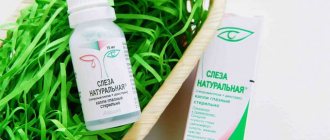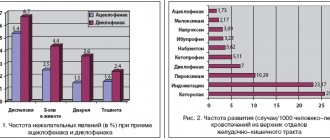Composition and release form
| Powder for preparing eye drops | 1 ml |
| (ready-to-use solution) | |
| active ingredients contained in the lid container: | |
| rolitetracycline | 0.005 g |
| (equivalent to tetracycline 0.421 g) | |
| chloramphenicol | 0.004 g |
| colistimethate sodium | 180000 IU |
| filler contained in the lid tank: | |
| sodium sulfite | 0.001 g |
| fillers contained in the solvent: benzalkonium chloride (preservative); sodium tetraborate; boric acid; sodium edetate; polysorbate 80; sterile distilled water |
in 5 ml bottles (complete with a reservoir cap and a dropper cap); 1 set in a cardboard pack.
| Eye ointment | 1 g |
| tetracycline | 0.005 g |
| chloramphenicol | 0.01 g |
| colistimethate sodium | 180000 IU |
| excipients: vaseline oil; lanolin; Vaseline ophthalmic |
in aluminum tubes of 5 g; in a cardboard pack 1 tube.
Colbiocin, eye drops and ointment. Fifteen years in ophthalmological practice in Russia
in ophthalmologic practice in Russia Yu.F. Maichuk Moscow NII of Eye Diseases named after Helmholtz. The author makes a review of the results of clinical studies of Colbiocin in the treatment of Chlamydia conjunctivitis, bacterial blepharitis and bacterial ulcer of cornea. These data show good tolerability and efficacy of Colbiocin. Clinical studies of a large group of ophthalmic drugs from the famous pharmaceutical company S.I.F.I. (Italy) were carried out at the Department of Infectious and Allergic Eye Diseases of the Moscow Research Institute of Eye Diseases named after. Helmholtz and in a number of other large clinics. All drugs showed the highest therapeutic efficacy and were well tolerated. Based on the results of these studies, the Pharmacological Committee of the Ministry of Health authorized the medical use of the following drugs, which have become firmly established in ophthalmological practice in Russia: Colbiocin - a combination of three antibiotics, eye drops - tetracycline 0.4%, chloramphenicol 0.4%, sodium colistimethate 1.33% - 5 ml in a dark glass bottle; eye ointment – tetracycline 0.4%, chloramphenicol 0.4%, sodium colistimethate 1.33% – 5 g in an aluminum tube. Prenacid – corticosteroid, desonide disodium phosphate eye drops 0.25% (10 ml in a dark glass bottle); desonide disodium phosphate ophthalmic ointment 0.25% (10 g in an aluminum tube). Octilia - decongestant eye drops, tetrahydrozoline hydrochloride 0.05%, distilled linden water, distilled chamomile water, 8 ml in a soft polyethylene bottle. Lacrisify - artificial tears, hydropropyl methylcellulose 0.5%, 10 ml. Myrtilene forte – soft gelatin capsules containing dry hydroalcoholic blueberry extract (25% anthocyanidins) 177 mg – retinotrophic and capillary protector. Three more drugs (Eubetal, Vitadral and Lubrifilm) were highly appreciated during the research period, but have not entered into practice in recent years. After our first report in the domestic literature in 1990 [10] about the high effectiveness of S.I.F.I. More than 40 articles were published. All studies indicate the advisability of using these drugs in the treatment of various eye diseases. Preparations of the company S.I.F.I. have become such a common component in the treatment of eye diseases that they are included in special guidelines and manuals [1,7,9,11], in manuals and reference books [6,13,14,15], in textbooks on eye diseases [3,4 ]. After the official distributor of the company S.I.F.I. (Italy) in Russia, a representative office became available. The drugs were re-registered and re-entered into pharmacies. In this regard, it is advisable to evaluate the clinical significance of these drugs in modern ophthalmology. Colbiocin, eye drops and eye ointment. As stated above, the drug includes three antibiotics, which provides the widest antibacterial spectrum and makes Colbiocin the drug of choice in the empirical treatment of bacterial eye diseases. Tetracycline and chloramphenicol, which are part of the drug, are active against gram-negative and gram-positive bacteria, microplasma and chlamydia. Colistin is highly effective against Pseudomonas aeruginosa, gram-negative bacteria and some fungi. It is important that Colbiocin eye ointment is made on a good ointment base, which significantly increases its tolerability compared to other eye ointments. In the field of epidemiology of bacterial eye diseases, the following negative trends have been noted in recent years: – growth of resistant strains of pathogens (up to 70% to some aminoglycosides), multiresistance; – a shift towards gram-negative pathogens, more aggressive, such as Pseudomonas aeruginosa; – more than 30% of bacterial keratitis are associated with wearing contact lenses. – toxic-allergic reactions to intensive, uncontrolled, long-term use of modern therapy drugs have become more common; here, low-quality drugs and the danger of an allergic reaction to preservatives and the medicinal base of eye drops are of important causal importance. It is in these changing epidemiological conditions that eye drops and eye ointment Colbiotsin have significant advantages due to a very wide spectrum of antibacterial activity, complex composition and good tolerance. It is known that inflammatory eye diseases account for 40-50% of outpatient appointments with an ophthalmologist, occupying the bulk of patients with the so-called “red eye syndrome”. Almost any bacterial infection can cause inflammation of the eyelids, conjunctiva and cornea. Among inflammatory eye diseases, the largest group consists of conjunctivitis - 66.7%, and blepharitis - 23.3%. Although keratitis accounts for no more than 5%, this form of eye disease is considered in the world as an important cause of decreased vision and blindness. Over many years of observation, extensive experience has been accumulated in the use of Colbiocin in the treatment of bacterial and chlamydial conjunctivitis, bacterial blepharitis, bacterial and fungal keratitis, in the prevention of infection during corneal trauma and after eye surgery. Chlamydial conjunctivitis. Our first observations on the use of Colbiocin in the treatment of 37 patients [10] and in general regarding the study of the drug, the largest number of publications on Colbiocin concern chlamydial conjunctivitis [2]. As we gained experience using Colbiocin and comparative studies, we settled on the following optimal method of using Colbiocin in the treatment of chlamydial conjunctivitis: Colbiocin eye ointment 4 times a day (reducing by one each subsequent week of treatment) or Colbiocin eye drops 4 times a day (also reducing the number of injections each week). From the beginning of the third week of treatment, instillations of Oftan-dexamethasone eye drops or Prenacid drops were added once a day, from the fourth week - 2 times a day. As our observations have shown, earlier or more frequent use can provoke an exacerbation of chlamydial infection. For moderate and severe chlamydial conjunctivitis, an antibiotic with anti-chlamydial activity is added from the first day of systemic treatment: (Tavanic) levofloxacin 500 mg once a day, ciprofloxacin (Ciprobid) 250 mg or moxifloxacin (Avelox) 400 mg once a day . In comparative studies, these antibiotics have a more pronounced overall anti-infective effect than tetracycline [7]. The use of such a treatment algorithm for 34 patients (63% with concomitant urogenital infection) made it possible to obtain a good therapeutic effect with recovery on average in 19.9 days. As an alternative therapy, we can recommend local treatment combining Okacin eye drops 4 times a day and Colbiocin eye ointment 4 times a day, alternating their administration. In 14 cases where patients applied late with a toxic-allergic reaction to previous treatment (erythromycin, oral tetracycline, Zovirax, Poludan), the use of Prenacid eye drops had a good effect from the first days of treatment with Colbiocin [2]. The treatment algorithm for chlamydial conjunctivitis using Colbiocin also turned out to be effective in preventing the development of persistent secondary dry eye. Against the background of antichlamydial treatment, in cases of signs of dry eye, the addition of instillations of artificial tears - Lacrisify or Hypromelose-R 2-3 times a day allows you to restore tear production within 2-3 weeks. The use of such treatment made it possible to restore the Schirmer test to normal in 63% of patients [9]. In comparative studies in Italy in the treatment of acute bacterial conjunctivitis, the use of Colbiocin eye drops led to recovery in 86.4%, and improvement in 9.1%, while the use of Tobramycin eye drops - in 63.2%, improvement in 5 .3% [16]. The laboratory examination data of these groups of patients deserve special attention: the sensitivity of the isolated microflora to Colbiocin is 100%, to Tobramycin – 88.4%. Blepharitis is bacterial. Blepharitis and blepharoconjunctivitis are common, extremely persistent eye lesions that are difficult to treat. An examination of 75 patients made it possible to confirm a bacterial infection, mainly staphylococcal, in 25% and staphylococcal in combination with demodicosis in 36% of patients. In the treatment of such patients, preference is given to the combined use of an antibiotic + corticosteroid. A good therapeutic result is achieved by the combined use of Colbiocin ophthalmic ointment and Prenacid ointment. Careful eyelid hygiene is necessary. Crusts and discharge are removed with a damp swab. For symptoms of conjunctivitis, you can additionally instill Dexon or Betagenot eye drops 2 times a day. Chronic blepharoconjunctivitis is often combined with dysfunction of the meibomian glands. We observed 53 patients with this diagnosis [12]. Blepharitis leads to stagnation of the meibomian lipid layer and glandular duct obstruction or ductal keratinization. Among patients with blepharoconjunctivitis, dry eye syndrome was detected in 87% [9]. In the treatment of such patients, in addition to anti-inflammatory drugs (Colbiocin, Prenacid), it is necessary to add tear replacement therapy: Lacrisifi, Defislez or Hypromeloza-R 2-3 times a day. In case of prolonged blepharoconjunctivitis with dysfunction of the meibomian glands, this treatment led to a significant improvement in the condition of the eyelids in 69% of patients, normalization of tear production in 47% and improvement of tear production in 32%, while reducing the duration of treatment by 30% [12]. Bacterial corneal ulcer. In the article by L.A. Kononenko and Yu.F. Maichuk (2004) [5] analyzed the use of Colbiocin in the treatment of 164 patients, including 10 with keratouveitis, 35 with keratouveitis with ulceration, 88 with corneal ulcer, 17 with stromal keratitis (of which 11 acanthamoeba) and 14 patients with stromal keratitis with ulceration (6 of them are Acanthamoeba). Microflora was detected in 83 patients, including staphylococcus in 21, pneumococcus in 12, staphylococcus + pneumococcus in 7 and Pseudomonas aeruginosa in 43 patients. In 22 patients the disease was classified as mild. In 51 – moderate and in 91 patients – severe. For mild corneal ulcers, Kolbiocin instillation was prescribed 4-6 times a day; for moderate and severe forms, Kolbiocin drops were used according to the accelerated method described earlier. For moderate and severe keratitis, Kolbiocin eye ointment was additionally used 2-4 times a day. Intensive antibacterial therapy was supplemented by instillations of mydriatics, anti-inflammatory drugs and metabolic and antioxidant agents. The complex treatment also included parabulbar and intramuscular injections of antibiotics. Clinical observations confirmed the high therapeutic effectiveness of Colbiocin eye drops and ointment - recovery in 98.1%, recovery time in mild cases - 7.6 days, moderate - 14.3 days, severe - 24.8 days. Thus, long-term clinical observations have shown that eye drops and eye ointment Colbiotsin have high therapeutic effectiveness in the treatment of bacterial eye diseases. Noteworthy is the good tolerability of the drugs.
Literature 1. Balashevich L.I., Vakhova E.S., Maychuk Yu.F. and others. Ophthalmochlamydia. St. Petersburg 1998, 32 P. 2. Vakhova E.S., Maichuk Yu.F. // New drugs. 2005. – No. 11. – pp. 15-17. 3. Eye diseases. Textbook ed. V.G. Kopaeva. M., 2002. 4. Eye diseases. Textbook ed. S.N. Fedorova, N.S. Yartseva, A.O. Ismankulova. M. 2005. – 440С. 5. Kononenko L.A., Maichuk Yu.F.// Refrakts. Surgery and ophthalmol. 2004. – No. 3. – pp. 39-42. 6. Kurenkov V.V. // Guide to excimer laser surgery of the cornea. M., 2002, 398 P. 7. Maichuk Yu.F., Vakhova E.S. // Clinic, diagnosis, differential diagnosis and treatment of paratrachoma. Information mail. M., 1995. 11 P. 8. Maichuk Yu.F., Vakhova E.S. // Refraction. Surgery and ophthalmology, 2004. – No. 4. – pp. 43-47. 9. Maychuk Yu.F., Vakhova E.S., Maychuk D.Yu., Mironkova E.A., Yani E.V. Algorithms for the treatment of acute infectious conjunctivitis aimed at preventing the development of dry eye syndrome. A manual for doctors. M. – 2004. – 20 P. 10. Maichuk Yu.F., Zatsepina N.D., Grishakova M.B. // Current issues in the diagnosis and treatment of chlamydial infections. M. 1990. – P. 122-127. 11. Maichuk Yu.F., Kononenko L.A., Vakhova E.S. // New drugs in the treatment of bacterial keratitis and chlamydial conjunctivitis. Methodological manual for doctors. M. 1998, 12 P. 12. Maichuk Yu.F., Mironkova E.A. // New drugs. drugs. 2005. – No. 11. – pp. 27-30. 13. Rational antimicrobial pharmacotherapy. Guide ed. V.P. Yakovlev and S.V. Yakovleva, M. 2003. – P. 443-465. 14. Directory. Pharmacotherapy of eye diseases. Ed. IN AND. Morozova and A.A. Yakovleva. M., 1998, 333 P. 15. Formal system. Ophthalmology. Medicines. M. 2005. – P. 589-609. 16. Fantinati et al // Bollettino di oculistica. 1990 – v.69. – P.299 – 307.
Pharmacodynamics
Combined antibacterial drug.
Chloramphenicol is a broad-spectrum antibiotic that inhibits the synthesis of proteins of sensitive microorganisms; active against gram-positive and gram-negative bacteria, Mycoplasma spp., Ricketsia spp., Chlamydia spp.; not active against Pseudomonas aeruginosa, fungi.
Tetracycline is a broad-spectrum antibiotic that inhibits bacterial protein synthesis at the RNA level and has a bacteriostatic effect. Active against gram-negative bacteria, Chlamydia spp., Mycoplasma spp., Ricketsia spp., Entamoeba histolytica. Microbial resistance develops slowly.
Colistin is an antibiotic isolated from Bacillus polymyxa (var. colistinus). It has a bactericidal effect on most gram-negative bacteria (including Pseudomonas spp., Haemophilus spp.), and is active against fungi. There is no cross-resistance with broad-spectrum antibiotics, with which colistin exhibits synergism.
Colbiocin 120mg 5ml powder for eye drops
Composition and release form Colbiocin 120 mg 5 ml powder for the preparation of eye drops
Powder for the preparation of eye drops - 1 ml (ready-to-use solution) active ingredients contained in the lid reservoir: rotetracycline - 0.005 g (equivalent to tetracycline 0.421 g) chloramphenicol - 0.004 g sodium colistimethate - 180,000 IU excipient contained in the lid reservoir: sodium sulfite - 0.001 g fillers contained in the solvent: benzalkonium chloride (preservative); sodium tetraborate; boric acid; sodium edetate; polysorbate 80; sterile distilled water in 5 ml bottles (complete with a reservoir cap and a dropper cap); 1 set in a cardboard pack. Eye ointment - 1 g tetracycline - 0.005 g chloramphenicol - 0.01 g sodium colistimethate - 180,000 IU excipients: vaseline oil; lanolin; Vaseline for eyes in aluminum tubes of 5 g; in a cardboard pack 1 tube.
Description of the dosage form
Eye drops: colorless or light yellow transparent liquid. Eye ointment: semi-solid yellow mass.
Directions for use and doses
Eye drops Conjunctivally, 1-2 drops 3-4 times a day or as individually prescribed by the attending physician. Rules for using the bottle 1. Following the existing notches on the aluminum capsule of the bottle, tear off the upper circumference of the capsule, and then the side. 2. Remove the cap from the bottle and adapt the reservoir to it. 3. Press the red reservoir cap into the bottle and then shake the bottle vigorously to dissolve the powder inside. 4. Remove the reservoir completely and place a dropper (pipette) on the bottle. Remove the cap from the dropper (pipette) and, turning the bottle over, squeeze out a drop. Eye ointment: put into the lower conjunctival fornix 3-4 times a day. When combined with the use of eye drops, it is enough to use eye ointment once a night.
Pharmacodynamics
Combined antibacterial drug. Chloramphenicol is a broad-spectrum antibiotic that inhibits the synthesis of proteins of sensitive microorganisms; active against gram-positive and gram-negative bacteria, Mycoplasma spp., Ricketsia spp., Chlamydia spp.; not active against Pseudomonas aeruginosa, fungi. Tetracycline is a broad-spectrum antibiotic that inhibits bacterial protein synthesis at the RNA level and has a bacteriostatic effect. Active against gram-negative bacteria, Chlamydia spp., Mycoplasma spp., Ricketsia spp., Entamoeba histolytica. Microbial resistance develops slowly. Colistin is an antibiotic isolated from Bacillus polymyxa (var. colistinus). It has a bactericidal effect on most gram-negative bacteria (including Pseudomonas spp., Haemophilus spp.), and is active against fungi. There is no cross-resistance with broad-spectrum antibiotics, with which colistin exhibits synergism.
Indications for use Colbiocin 120 mg 5 ml powder for the preparation of eye drops
conjunctivitis (catarrhal, purulent, trachoma); blepharitis; blepharoconjunctivitis; bacterial keratitis; septic corneal ulcer; dacryocystitis.
Contraindications
individual hypersensitivity to the components of the drug; dysfunction of the liver, kidneys; pregnancy; lactation period; children's age (up to 8 years).
Application of Colbiocin 120 mg 5 ml powder for the preparation of eye drops during pregnancy and breastfeeding
Contraindicated during pregnancy. Breastfeeding should be stopped during treatment.
Side effects Colbiocin 120mg 5ml powder for eye drops
Eye drops contain sodium sulfite; this component of the drug can provoke allergic reactions and severe asthma attacks in people sensitive to it (especially asthmatics). Since rare cases of bone marrow hypoplasia have been reported due to long-term topical use of chloramphenicol, the drug should be used for short periods of time and under the supervision of an ophthalmologist. Prolonged use of topical antibiotics may cause symptoms of local irritation (transient conjunctival hyperemia). Cases of hypersensitivity symptoms such as burning, angioedema, urticaria, bullous and maculopapular dermatitis have been reported, which requires discontinuation of the drug.
Drug interactions
When using Kolbiocin topically, no pharmacological interactions with other drugs were detected.
Side effects
Eye drops contain sodium sulfite; this component of the drug can provoke allergic reactions and severe asthma attacks in people sensitive to it (especially asthmatics).
Since rare cases of bone marrow hypoplasia have been reported due to long-term topical use of chloramphenicol, the drug should be used for short periods of time and under the supervision of an ophthalmologist.
Prolonged use of topical antibiotics may cause symptoms of local irritation (transient conjunctival hyperemia). Cases of hypersensitivity symptoms such as burning, angioedema, urticaria, bullous and maculopapular dermatitis have been reported, which requires discontinuation of the drug.
Directions for use and doses
Eye drops
Conjunctivally, 1-2 drops 3-4 times a day or as individually prescribed by the attending physician.
Rules for using the bottle
1. Following the existing notches on the aluminum capsule of the bottle, tear off the upper circumference of the capsule, and then the side.
2. Remove the cap from the bottle and adapt the reservoir to it.
3. Press the red reservoir cap into the bottle and then shake the bottle vigorously to dissolve the powder inside.
4. Remove the reservoir completely and place a dropper (pipette) on the bottle. Remove the cap from the dropper (pipette) and, turning the bottle over, squeeze out a drop.
Eye ointment: put into the lower conjunctival fornix 3-4 times a day. When combined with the use of eye drops, it is enough to use eye ointment once a night.
Colbiocin, eye ointment, 5 g, 1 pc.
Dosage forms:
Eye drops, eye ointment.
Composition of 100 ml ready-to-use solution:
active ingredients contained in the lid container:
Rotetracycline – 0.500 g (amount equivalent to tetracycline 0.421 g), chloramphenicol – 0.400 g, sodium colistimethate – 18000000 IU;
fillers contained in the lid tank:
sodium sulfite – 0.100 g;
fillers contained in the solution:
benzalkonium chloride (preservative), sodium tetraborate, boric acid, sodium edetate, polysorbate 80, sterile distilled water.
Composition of 100 g eye ointment:
active components:
tetracycline – 0.500 g, chloramphenicol – 1.000 g, sodium colistimethate – 18000000 IU;
other ingredients:
Vaseline oil, lanolin, ophthalmic petrolatum.
Description of dosage forms:
Eye drops: colorless or light yellow transparent liquid; eye ointment: semi-solid yellow mass.
Pharmacological properties
Combined antibacterial drug.
Chloramphenicol is a broad-spectrum antibiotic that inhibits the synthesis of proteins of sensitive microorganisms; active against gram-positive and gram-negative bacteria, Mycoplasma spp., Ricketsia spp., Chlamydia spp.; not active against Pseudomonas aeruginosa, fungi.
Tetracycline is a broad-spectrum antibiotic that inhibits bacterial protein synthesis at the RNA level and has a bacteriostatic effect. Active against gram-negative bacteria, Chlamydia spp., Mycoplasma spp., Ricketsia spp., Entamoeba histolytica. Microbial resistance develops slowly.
Colistin is an antibiotic isolated from Bacillus polymyxa, var. colistinus. Has a bactericidal effect on most gram-negative bacteria (including Pseudomonas spp., Haemophilus spp.); active against fungi. There is no cross-resistance with broad-spectrum antibiotics, with which colistin exhibits synergism.
Indications for use
- conjunctivitis (catarrhal, purulent, trachoma);
- blepharitis;
- blepharoconjunctivitis;
- bacterial keratitis;
- septic corneal ulcer;
- dacryocystitis.
Contraindications
- individual hypersensitivity to the components of the drug;
- dysfunction of the liver, kidneys;
- pregnancy and lactation;
- children up to 8 years old.
Directions for use and doses
Eye drops: 1-2 drops 3-4 times a day or as individually prescribed by your doctor.
Rules for using the bottle:
- 1. Following the existing notches on the aluminum capsule of the bottle, tear off the upper circumference of the capsule, and then the side. 2. Remove the cap from the bottle and adapt the reservoir to it. 3. Press the red reservoir cap into the bottle and then shake the bottle vigorously to dissolve the powder inside. 4. Remove the reservoir completely and place a dropper (pipette) on the bottle. Remove the cap from the dropper (pipette), and, turning the bottle over, squeeze out a drop.
Eye ointment: apply to the lower conjunctival fornix 3-4 times a day. If the use of eye drops is combined with the use of ointment, then using the eye ointment once a night is sufficient.
Side effect
Eye drops contain sodium sulfite; this component of the drug can provoke allergic reactions and severe asthma attacks in persons sensitive to it and, especially in asthmatics.
Since rare cases of bone marrow hypoplasia have been reported due to long-term topical use of chloramphenicol, the drug should be used for short periods of time and under the supervision of an ophthalmologist.
Prolonged use of topical antibiotics may cause symptoms of local irritation (transient conjunctival hyperemia). Cases of hypersensitivity symptoms such as burning, angioedema, urticaria, bullous and maculopapular dermatitis have been reported, which requires discontinuation of the drug.
Overdose
There are no cases of overdose with the use of Colbiocin.
Interaction with other drugs
When using Kolbiocin topically, no pharmacological interactions with other drugs were detected.
special instructions
If there is no significant clinical improvement within a relatively short period of time or allergic reactions to the components of the drug occur, it is necessary to interrupt treatment and prescribe appropriate therapy.
Release form
Eye drops (ready-to-use): 5 ml in a bottle. Eye ointment: 5 g in a tube.
Storage conditions
List B. At a temperature not higher than 25°C. Keep out of the reach of children!
Best before date
Eye drops: 2 years (until opening the package). After opening the bottle, the drug should be stored in the refrigerator at 2-8°C and used within 15 days.
Eye ointment: shelf life 3 years (before opening the package). After opening the tube, the drug should be used within 30 days.
Do not use after the expiration date indicated on the package!
Conditions for dispensing from pharmacies
By doctor's prescription.
Manufacturing company
S.I.F.I. S.p.A





